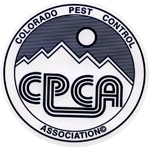Pest Library - Stinging Insects
Bees
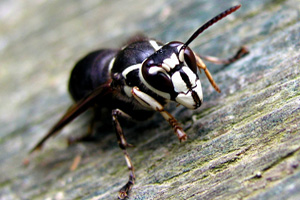
Bees are flying insects closely related to wasps and ants, and are known for their role in pollination and for producing honey and beeswax. Bees are a monophyletic lineage within the superfamily Apoidea, presently classified by the unranked taxon name Anthophila. There are nearly 20,000 known species of bees in seven to nine recognized families, though many are undescribed and the actual number is probably higher. They are found on every continent except Antarctica, in every habitat on the planet that contains insect-pollinated flowering plants.
Bees and humans
Bees figure prominently in mythology and have been used by political theorists as a model for human society. Journalist Bee Wilson states that the image of a community of honey bees "occurs from ancient to modern times, in Aristotle and Plato; in Virgil and Seneca; in Erasmus and Shakespeare; Tolstoy, as well as by social theorists Bernard Mandeville and Karl Marx."
Despite the honey bee's painful sting and the stereotype of insects as pests, bees are generally held in high regard. This is most likely due to their usefulness as pollinators and as producers of honey, their social nature, and their reputation for diligence. Bees are one of the few insects regularly used on advertisements, being used to illustrate honey and foods made with honey (such as Honey Nut Cheerios).
Bald-faced Hornet

Dolichovespula maculata is a North American insect commonly called the bald-faced hornet (or white-faced hornet or white-tailed hornet). Its well-known features include its hanging paper nests and the females' habit of defending them with repeated stings.
The bald-faced hornet is 1/2 to 5/8 in (1.25 to 1.6 cm) long. It is black with white markings on the face, the thorax, the last few segments of the abdomen, and the first segment of the antennae. The wings are smoke-colored and the eyes are brown. It belongs to a genus of wasps called yellowjackets in North America, but is not called that because it lacks yellow coloring. Instead, it is called a hornet in the American sense of a wasp that builds paper nests, especially one of the subfamily Vespinae. It is not a "true hornet" in the British sense, that is, a member of the genus Vespa in the same subfamily, such as the Asian giant hornet or the European hornet.
European Paper Wasp
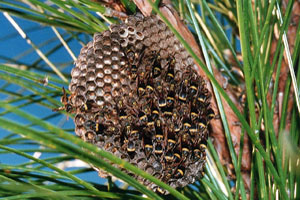
Polistes dominula, sometimes referred to as the European Paper Wasp, is one of the more common and well-known species of social wasps in Europe. It is considered an invasive species in Canada and the United States.
The native range of P. dominula covers much of southern Europe and North Africa, and temperate parts of Asia as far east as China. It has also been introduced to Australia and North and South America. This species was introduced into the United States in 1968 in the New Jersey Pine Barrens and spread throughout most of the country during the 1980s and 90s, in some cases partially replacing native species. Another introduction was discovered in the late 1970s in Cambridge, Newton and Somerville, Massachusetts. The first wave consisted of solitary-founding but socially-nesting individuals, then a wave of social founders (several females found a new nest together). In warmer regions there have been reports of "supercolonizers" most of whom enlarge their natal nests in successive years, rather than dispersing.
In the United States, Polistes dominula nests earlier in the spring, in a wider variety of nest sites, and feeds on a larger variety of insects than native species, which feed almost exclusively on caterpillars. Most entomologists consider it to be an invasive species. This wasp can be mistaken for a yellowjacket, as it is black strongly marked with yellow, in a pattern very reminiscent of a yellowjacket, and quite different from the native North American species of Polistes.
Honey Bee
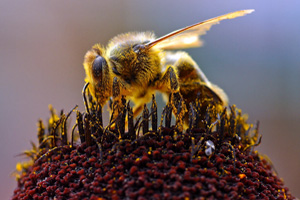
Honey bees (or honeybees) are a subset of bees in the genus Apis, primarily distinguished by the production and storage of honey and the construction of perennial, colonial nests out of wax. Honey bees are the only extant members of the tribe Apini, all in the genus Apis. Currently, there are only seven recognized species of honey bee with a total of 44 subspecies (Engel, 1999) though historically, anywhere from six to eleven species have been recognized. Honey bees represent only a small fraction of the approximately 20,000 known species of bees. Some other types of related bees produce and store honey, but only members of the genus Apis are true honey bees.
Africanized Bee
Widely known as the "killer bee", Africanized bees are highly defensive hybrids between European stock and the African subspecies A. m. scutellata; they are thus often called "Africanized bees". Originating by accident in Brazil, they have spread to North America and constitute a pest in some regions. However, these strains do not overwinter well, and so are not often found in the colder, more Northern parts of North America. On the other hand, the original breeding experiment for which the African bees were brought to Brazil in the first place has continued (though not as intended): novel hybrid strains of domestic and re-domesticated Africanized bees combine high resilience to tropical conditions and good yields, and are popular among beekeepers in Brazil.
Yellow Jacket
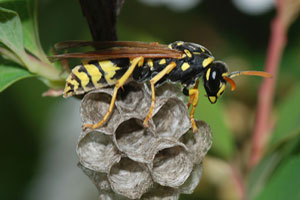
Yellow jacket or yellow-jacket is the common name in North America for predatory wasps of the genera Vespula and Dolichovespula. Members of these genera are known simply as a "wasp" in other English-speaking countries. Most of these are black-and-yellow; some are black-and-white (such as the bald-faced hornet, Dolichovespula maculata), while others may have the abdomen background color red instead of black. They can be identified by their distinctive markings, small size (similar to a honey bee), their occurrence only in colonies, and a characteristic, rapid, side to side flight pattern prior to landing. All females are capable of stinging which can cause pain to the person that has been stung. Yellowjackets are important predators of pest insects.
Due to their aggressive behavior, including stinging, many other insects exhibit mimicry of yellowjackets; in addition to numerous bees and wasps (Müllerian mimicry), the list includes some flies, moths, and beetles (Batesian mimicry). Yellowjackets' closest relatives, the hornets, closely resemble them but have a much bigger head, seen especially in the large distance from the eyes to the back of the head.
In 1975, the German yellow jacket first appeared in Ohio and has now become the dominant species over the Eastern Yellow Jacket. It is bold and aggressive, and if provoked, it can sting repeatedly and painfully. It will mark aggressors, and will pursue them if provoked. The German yellow jacket builds its nests in cavities (not necessarily underground) with the peak worker population in temperate areas between 1,000 and 3,000 individuals between May to August, each colony producing several thousand new reproductives after this point, through November. The Eastern Yellow Jacket builds its nests underground, also with the peak worker population between 1,000 and 3,000 individuals similar to the German yellow jacket. Nests are built entirely of wood fiber (usually weathered or dead) and are completely enclosed (football or soccer-ball shaped) except for a small opening (entrance) at the bottom. The color of the paper is highly dependent on the source of the wood fibers used. The nests contain multiple, horizontal tiers of combs (10 or more) within. Larvae hang down in combs.
In the Southeastern United States, where southern yellow jacket (Vespula squamosa) nests may persist through the winter, colony sizes of this species may reach 100,000 adult wasps.


